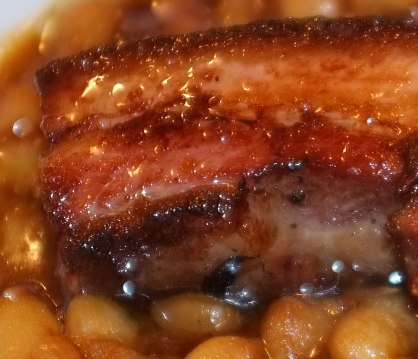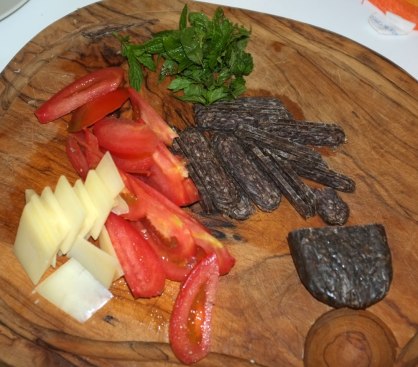
I have written in the past about “Antica Macelleria Cecchini” in Panzano, Tuscany, where my good friend Dario Cecchini transforms butchering into the poetry of every living.
I like meat markets, I like butcher shops.
It is not only the products but the atmosphere.

Today I want to share a totally different experience in a meat lover’s paradise in Illinois, USA: Ream’s Elburn Market.
Elburn is a small town, some 60 miles west of Chicago, in the middle of Illinois fields.
Ream’s Elburn Market is a family meat market that attracts meatlovers from the Chicago and suburbs area, also known as Chicagoland.

Lynn Meredith, of the Elburn Tribune, wrote in her April 2011 article:
“Ream’s Meat Market keeps on bringing home the bacon when it comes to making Elburn a destination for Chicagoland carnivores in search of the best in meats and sausages. Ream’s recently made the list of “Best Chicagoland Places to Eat,” by the LTH Forum, a Chicago-based culinary chat site whose 9,000 members make it their business to identify small, out-of-the-way eateries and resources for all things food.”

As you enter the store you are impressed by the awards on the walls, and some cans of lard from older days.
The meats, sausages, jerkies, smoked meats, fresh meats, and other products inside the store are more than a blog article can cover.
A lot more!
“I like to call it the shotgun approach,” Ream explains. “When you walk in the door, you are overwhelmed by so many meat selections that you don’t know where to go first.” (Source: Upbeat in Elburn, by Steve Krut)
By necessity, I will confine myself to some representative selections, starting with sausages.
I could not resist to start with the tailgater brats with bacon and blue cheese.
Tailgate parties are a staple of US food culture and fun.

In addition to the US style sausages, there are a lot of European origin, like the Hungarian style sausage.

No sausage tray would be complete without a white sausage from Bavaria.
True to their calling, the Ream family produce one of the best weisswursts outside Bavaria.
We prepared them with sauerkraut and they were delicious!

Italy has very strong presence in the US culinary scene. Here are some Mild Italian Sausages.

I conclude the sausage section with another American sausage: Jalapeno and cheese.
I wish I could have tasted them all on the spot, but I couldn’t!

Moving on to the smoked products, I would like to start with the salmon.
I bought some and was handsomly rewarded. It was juicy, moist and with a subtle smoky flavor.

Bacon is next.

Dry cured bacon and Hungarian style.

The bacon was so good, I cooked it for breakfast in a “Bacon and eggplant omelette”.

Jerkies are one of the reasons why Ream’s Elburn Market is so famous.
“Jerky is lean meat that has been trimmed of fat, cut into strips, and then dried to prevent spoilage. Normally, this drying includes the addition of salt, to prevent bacteria from developing on the meat before sufficient moisture has been removed. The word “jerky” is derived from the Spanish word charqui which is from the Quechua word ch’arki. which means to burn (meat). All that is needed to produce basic “jerky” is a low-temperature drying method, and salt to inhibit bacterial growth.” (Source: Wikipedia).

In principle, jerky is similar to the Turkish and Middle-Eastern pastirma, although pastirma is not sliced in advance, but only before it is consumed.
California heat beef jerky.

And – of course – Elburner beef jerky.
“In the competitive meats arena, Ream hasn’t excelled…he’s exceeded. He has directed Elburn Market products to grand championship awards in 15 separate product classes at the American Cured Meat Championships (ACMC), something never done by any processor. His small shop has garnered an incredible 235 awards in cured meat competition!” ((Source: Upbeat in Elburn, by Steve Krut)

I now want to refer specifically to the cooked ham, which we bought and enjoyed on multiple occasions.

In the US the prime part of leg of pork, the ham, is sold also cooked. You do need to add anything to it, just warm it gently, slice and serve. In case of a high quality product, like the one we bought at Ream’s, you do want to taste the meat, rather than all the spices, sauses, and so on.

This top quality ham is moist, sweet, tender, it melts in your mouth and leaves a very subtle aftertaste.
It is time to have a look at the fresh meats on offer.
I start with my all time favourite, the T-bone steak. Look at the marbling of the meat!

More steaks are on offer. The rib eye comes next.

And a bone-in rib eye, thick and marbled to perfection. I perfect the bone-in because of the added flavor and the thickness of the cut.

I get hungry only by looking at the beautiful display.

There are also some prepared “composite” meat dishes, to cook and serve.
I start with a beautiful beef roulade, or pinwheel in American English.
“The word roulade originates from the French word “rouler” meaning “to roll” Typically, a roulade is a European dish consisting of a slice of meat rolled around a filling, such as cheese, vegetables, or other meats. A roulade, like a braised dish, is often browned then covered with wine or stock and cooked. Such a roulade is commonly secured with a toothpick, metal skewer or a piece of string. The roulade is then sliced into rounds and served.” (Source: Wikipedia).

The popeye pinwheel has – of course spinach.
The classic bacon wrapped pork filet is another temptation.

And another pinwheel, less colorful.

The emperor of meat cuts. the beef tenderloin concludes this representative sample of goods in Ream’s Elburn Market.

But may be not. As I was approaching the cash register, I saw the absolute delicacy, smoked porks ears. But they were not meant for human consumption. the sign clearly said: “For Dogs”. May be next time I will have my dog with me.



















































































































